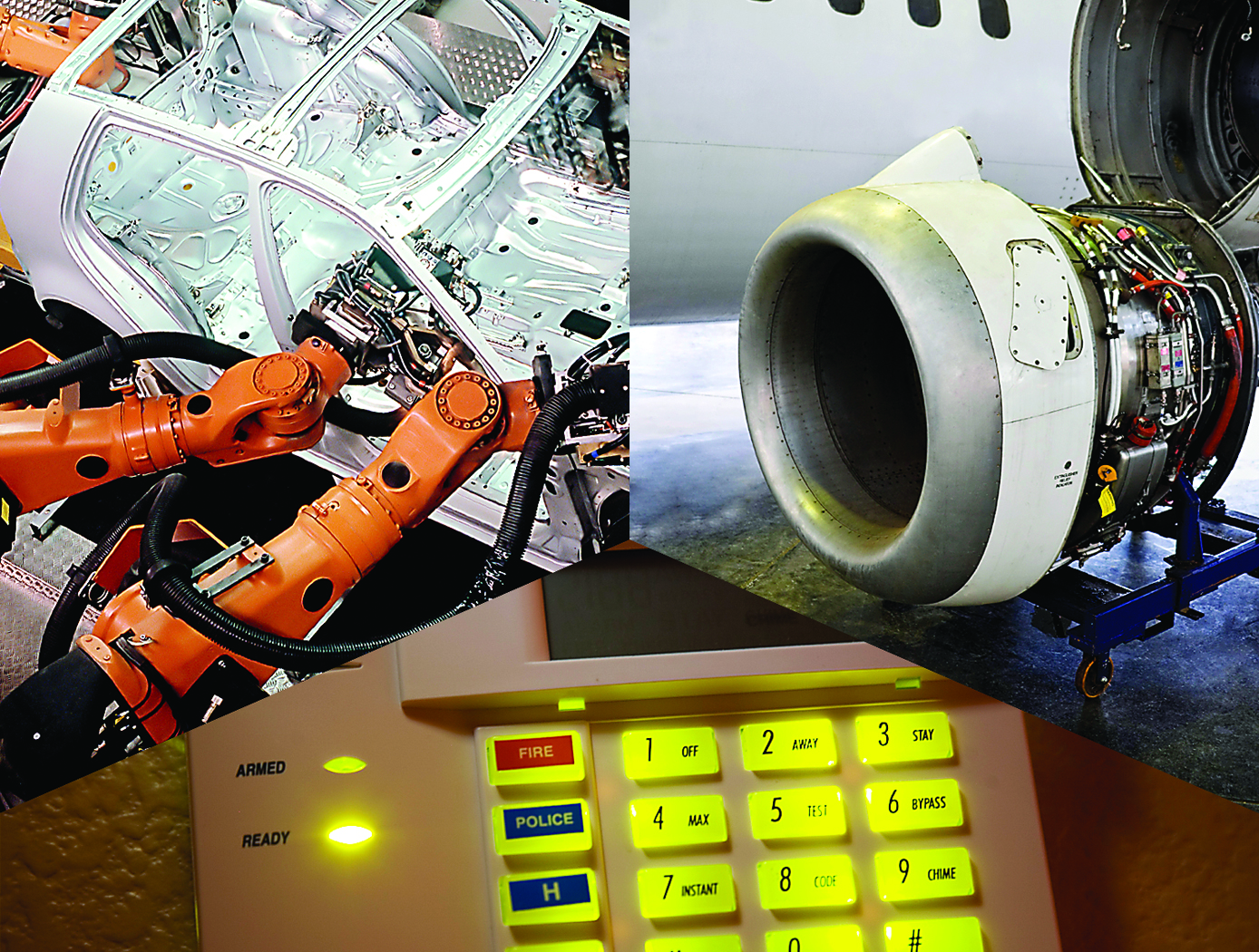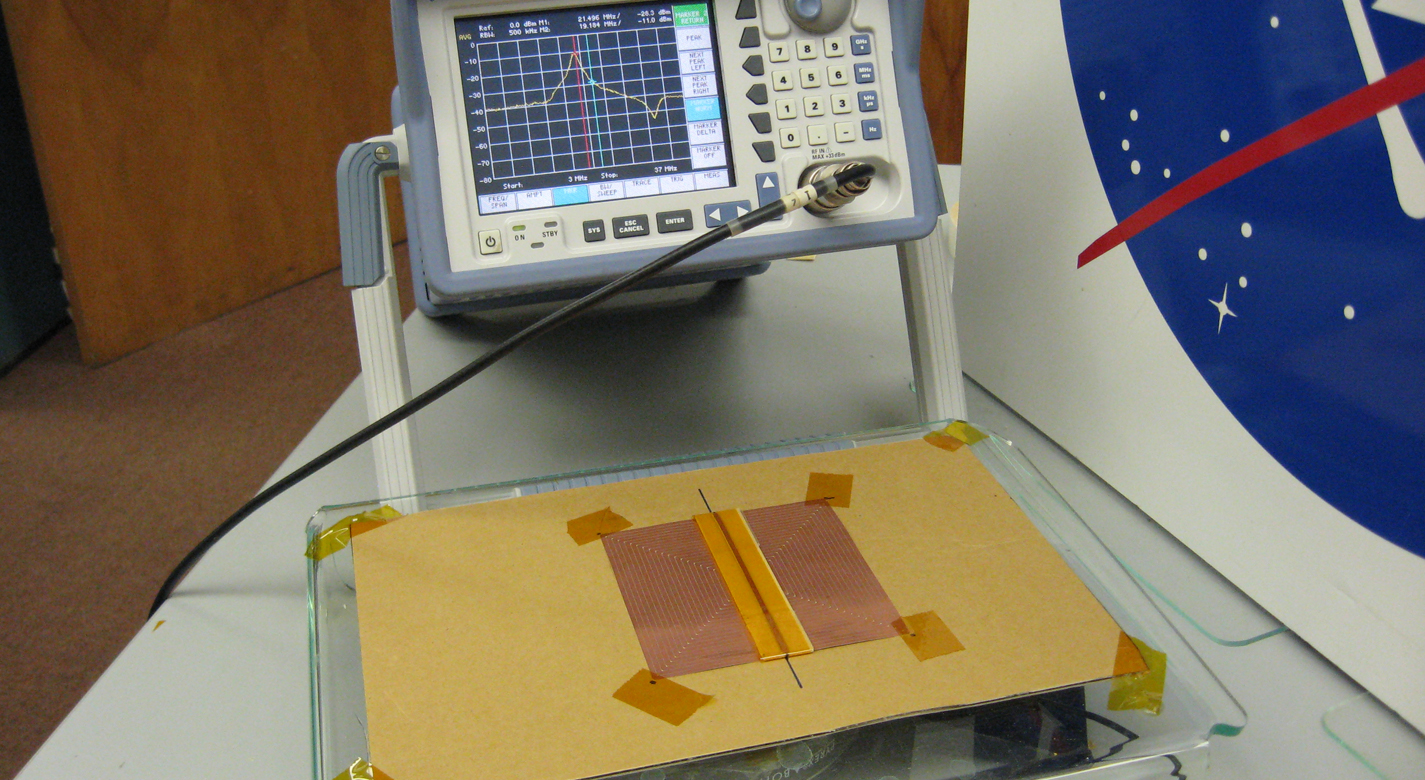Wireless Electrical Devices Using Floating Electrodes
sensors
Wireless Electrical Devices Using Floating Electrodes (LAR-TOPS-83)
Fundamental new approach for developing electrical devices that need no external power source or electrical connections
Overview
NASA's Langley Research Center researchers have developed a wireless, connection-free, open circuit technology that can be used for developing electrical devices such as sensors that need no physical contact with the properties being measured. At the core of the technology is the SansEC
[Sans Electrical Connections] circuit, which is damage resilient and environmentally friendly to manufacture and use. The technology uses a NASA award-winning magnetic field response measurement acquisition device to provide power to the device and, in the case of a sensor application, to acquire physical property measurements from them. This fundamental new approach using open circuits enables applications such as sensors for axial load force, linear displacement, rotation, strain, pressure, torque, and motion sensing, as well as unique designs such as for a wireless keypad or wireless rotational dial, or for energy storage.
The Technology
The technology presents a fundamental change in the way electrical devices are designed, using an open circuit in conjunction with a floating electrode, or an electrically conductive object not connected to anything by wires, and powered through a wireless device. This system uses inductor-capacitor thin-film open circuit technology. It consists of a uniquely designed, electrically conductive geometric pattern that stores energy in both electric and magnetic fields, along with a floating electrode in proximity to the open circuit. When wirelessly pulsed from the handheld data acquisition system (U.S. Patent Number 7,159,774, Magnetic Field Response Measurement Acquisition System), the system becomes electrically active and develops a capacitance between the two circuit surfaces. The result is a device that acts as a parallel plate capacitor without electrical connections.


Benefits
- Can measure shear force, torsion, in-plane strain, and relative position of two planes without electrical connections on either surface or between surfaces
- Out-of-plane measurements have sensitivity levels an order of magnitude better than other measurement methods
- One sensor can be used for multiple measurements
- Receives power wirelessly, eliminating the need for a sensor power source
- Sends signals wirelessly to the data acquisition device, eliminating signal wiring
- Reduces system weight and size due to less wiring
- Lowers the number of electrical connections within the circuit, improving reliability
- Can be mass produced, and is well suited for manufacture to a specific size
Applications
- Automation control - linear position sensors
- Security systems - wireless keypads and motion detectors
- Aerospace - testing and monitoring
Similar Results

Damage and Tamper Detection Sensor System
The SansEC sensor system consists of multiple pairs of inductor-capacitor sensors with no electrical connections, which are placed throughout the material being monitored for damage. The sensors are embedded in or placed directly onto the surface of the material. Strains and breaks are detected by changes in resonant frequency read by the accompanying magnetic field data acquisition system. When pulsed by a sequence of magnetic field harmonics from the acquisition system, the sensors become electrically active and emit a wireless response. The magnetic field response attributes of frequency, amplitude, and bandwidth of the inductor correspond to the physical property states measured by the sensor. The received response is correlated to calibration data to determine the physical property measurement. Because each sensor pair has its own frequency response, when damage occurs to that circuit the frequency response changes. This change identifies the damage location within the material.
A unique feature achieved by eliminating electrical connections is that damage to a single point will not prevent the sensor from being powered or interrogated. If a sensor is broken, two concentric inductively coupled sensors are created, thus identifying tamper or damage location.

SansEC Spectroscopy
This technology is a method of identifying material anomalies and defects on or within a material by observing and quantifying how a localized change in either conductivity, permeability or permittivity changes the responding electric field and magnetic fields. This approach has many advantages over typical spectroscopy methods, particularly because typical methods only measure changes in the electric field.
This advancement will allow for potentially deeper detection of a material's abnormalities/defects (including subsurface measurements) with limited electrical requirements. The technology has applications as diverse as medical oncology screenings or surface measurements of aeronautic skins.
Another promising application is bore hole geological spectroscopy. In such an application, an array of sensors could be embedded into bore hole drills for exploratory deep wells. As the drill tooling slides past the bore hole wall, spectroscopic sampling of the side walls reveals important dielectric property information that is highly useful to prospectors and geologists in determining the probability of specific resources that may exist in the subterranean geology.

Highly Accurate Level Sensor
The FAA and Aircraft Industry recognize the need to reduce fuel tank explosion risk
by eliminating ignition sources and changing fuel tank design and maintenance.
This technology can be utilized to wirelessly sense the level of fuel in aircrafts, thus
mitigating risk of inadvertent electrical failures and sparks. NO wires enter the fuel
tank and the radio frequency transponder typically requires 10 milliwatts of power or
less.
The technology can be used for dielectric tanks, by simply applying the sensors to the
tank surface (as pictured). Through certain techniques the technology can be applied
on metal tanks with no wires entering the tank from the outside.
Currently, there are more than 20,910 jet aircraft in service. This presents a large
market opportunity for retrofitting this technology onto existing airplane fuel tanks
Rapidly evolving aviation services are expected to spur worldwide requirement for
36,770 new jet aircraft by 2033. This presents a growing market for new installations.

Low-Profile Wireless Sensor
The low-profile sensor is configured with a spiral electrical trace on flexible substrate. In typical inductor designs, the space between traces is designed to minimize parasitic conductance to reduce the impact of the capacitance to neighboring electronics. In the low-profile sensor, however, greater capacitance is desired to allow the operation of an inductor-capacitor circuit. This allows the traces to be closer together, decreasing the
overall size of the spiral trace.
The sensor receives a signal from the accompanying magnetic field data acquisition system. Once electrically active, the sensor produces its own harmonic magnetic field as the inductor stores and releases magnetic energy. The antenna of the measurement acquisition system is switched from a transmitting to a receiving mode to acquire the magnetic-field response of the sensor. The magnetic-field response attributes of frequency, amplitude, and bandwidth of the inductor correspond to the physical property states measured by the sensor. The received response is correlated to calibration data to determine the physical property measurement. When multiple sensors are inductively coupled, the data acquisition system needs to activate and read
only one sensor to obtain measurement data from all of them.
Wireless Sensor for Pharmaceutical Packaging and Monitoring Applications
The SansEC sensor is an electrically open circuit without electrical connections. Having a device without circuits eliminates a common failure source of electrical systems. It consists of a uniquely designed thin-film electrically conductive geometric pattern that stores energy in both electric and magnetic fields. When wirelessly interrogated from the portable data acquisition system, the sensor becomes electrically active and emits a wireless response. The magnetic field response attributes of frequency, amplitude, and bandwidth of the inductor correspond to the physical property states measured by the sensor. Container damage, temperature, spoilage, or substance level is detected by changes in resonant frequency read by the accompanying magnetic
field data acquisition system. A unique feature of the sensor is its ability to measure more than one physical attribute at the same time. In addition, by eliminating electrical connections, damage to any area of the sensor will not prevent it from being powered or interrogated.



